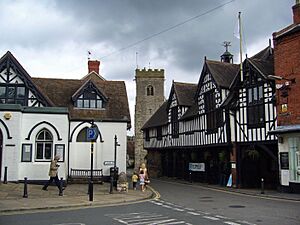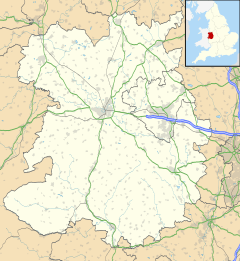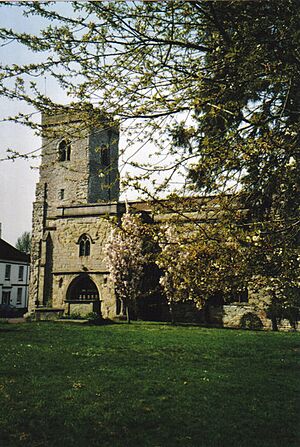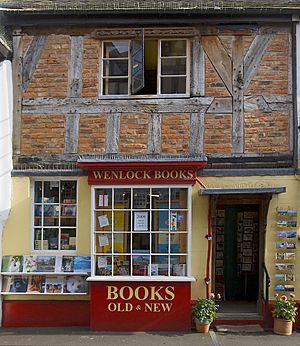Much Wenlock facts for kids
Quick facts for kids Much Wenlock |
|
|---|---|
 Holy Trinity Church (centre) and the Guildhall (right) |
|
| Population | 2,877 (2011) |
| OS grid reference | SO623997 |
| Civil parish |
|
| Unitary authority |
|
| Ceremonial county | |
| Region | |
| Country | England |
| Sovereign state | United Kingdom |
| Post town | MUCH WENLOCK |
| Postcode district | TF13 |
| Dialling code | 01952 |
| Police | West Mercia |
| Fire | Shropshire |
| Ambulance | West Midlands |
| EU Parliament | West Midlands |
| UK Parliament |
|
Much Wenlock is a historic market town in Shropshire, England. It is located between the towns of Shrewsbury and Bridgnorth. Close by, you can find the famous Ironbridge Gorge and the town of Telford.
The area around Much Wenlock includes smaller villages like Homer, Wyke, Atterley, Stretton Westwood, and Bourton. In 2011, about 2,877 people lived in the civil parish of Much Wenlock.
This town is famous for its historic buildings like Wenlock Priory, Holy Trinity Church, and the Much Wenlock Guildhall. It is also well-known for the Wenlock Olympian Games. These games were started by William Penny Brookes in 1850. He is seen as one of the people who helped create the modern Olympic Games. In fact, one of the mascots for the London 2012 Summer Olympics was named Wenlock after the town!
Contents
What's in a Name?
The name "Much Wenlock" helps tell it apart from a nearby place called Little Wenlock. "Much" means it is the larger of the two towns.
The name "Wenlock" likely comes from old words. "Wininicas" was a Celtic word meaning "white area," probably because of the white limestone rocks of Wenlock Edge. "Loca" is an Old English word meaning "enclosed place." The town was first written down as Wenloch in a very old book called the Domesday Book in 1086.
A Look Back in Time
Much Wenlock grew up around a special religious building called an abbey or monastery. This abbey was founded around the year 680 by Merewalh, a son of King Penda. King Penda's daughter, Milburga, became the abbess (leader) of the abbey in 687. People believed Milburga performed many amazing acts. The abbey was successful until about 874, when it was likely attacked by Vikings.
Later, in the 11th century, another religious house was built on the same spot. This was done by Leofric, Earl of Mercia and his wife, Countess Godiva. In the 12th century, a new Cluniac priory was built there by Roger de Montgomerie after the Normans took over England. You can still see the ruins of this priory today, and it is looked after by English Heritage. The priory thrived until 1539, when many monasteries were closed down.
Other interesting old buildings include the Guildhall, which is from the 16th century. Many other historic buildings in the town show the Early English style. There is also an annual well dressing event at St Milburga's Well.
In the 19th century, a lot of the town and land came into the hands of James Milnes Gaskell. His son, Charles Milnes Gaskell, and his wife, Lady Catherine, made the Priory lodging into their home. They welcomed many famous people there, including writers, politicians, artists, and explorers. Some of these guests were Thomas Hardy, Henry James, and Henry Morton Stanley.
Much Wenlock is especially famous as the birthplace of the Wenlock Olympian Games. These games were started by Dr William Penny Brookes and his Wenlock Olympian Society (WOS) in 1850. Dr Brookes is known as one of the founding fathers of the Modern Olympic Games. In 1890, the Raven Hotel hosted the dinner after the games. A very important guest that night was Baron Pierre de Coubertin, who helped bring back the modern Olympics. You can see copies of old WOS pictures and letters from Coubertin to Brookes in the hotel.
The Wenlock Olympian Games are still held every year in July. They are organized by the WOS. The secondary school in Much Wenlock is named after Dr Brookes.
To honor Dr Brookes and the town, the Olympic mascot for the London 2012 Games was named Wenlock. On May 30, 2012, the Olympic flame for the London 2012 Summer Games was carried through Much Wenlock. This was a way to remember Dr Brookes's important work.
Much Wenlock was also the first community in the West Midlands to have a special plan for its future development. This plan was approved by local voters in 2014.
Churches in Much Wenlock
Holy Trinity Church, on Wilmore Street, is the local Anglican church. The first church on this spot was built a very long time ago, during Anglo-Saxon times. The church you see today dates back to 1150. It was built by the Cluniac monks from Wenlock Priory.
Interesting parts of the church include its simple Norman tower. Inside, there is a memorial to W. P. Brookes. The churchyard is a large, green area with tall trees. There is also a Methodist church on King Street.
Other Interesting Buildings
Besides the churches, other notable buildings include the 16th-century Much Wenlock Guildhall and the Much Wenlock Corn Exchange from the mid-1800s.
Cultural Connections
- The annual Live Arts Festival takes place in March. It's part of the Wenlock Olympian Games and includes competitions in music, writing, and dance for young people.
- The nearby Wenlock Edge is a very important geological site. Both Wenlock Edge and the town are mentioned in poems by A. E. Housman in his famous book A Shropshire Lad.
- The Victorian artist Robert Bateman lived near Much Wenlock. His paintings were known for showing a "magic world of romance."
- The novelist Mary Webb lived just outside the town as a child from 1882 to 1896.
- The famous classicist Mary Beard was born here.
- St. Milburga's Well was once believed to cure eye diseases. In medieval times, many pilgrims visited the town to worship at St Milburga's Shrine.
- The London 2012 Summer Olympics mascot, Wenlock, was named after the town to honor Dr W.P. Brookes.
- Much Wenlock hosts an annual Poetry Festival after Easter. The poet Carol Ann Duffy is a patron of this festival.
- The English actress Rosemary Leach was born here.
- The actress Gabrielle Drake lives in Wenlock Priory.
- Isobel Cooper, an operatic pop singer known as Izzy, was born in Much Wenlock in 1975.
Films Made Here
- In 1950, the film Gone to Earth was filmed in and around Much Wenlock. This movie was based on a novel by Shropshire writer Mary Webb.
- Parts of the John Cleese film Clockwise were also filmed in the area.
- The Guildhall in Much Wenlock was used as a nightclub in parts of the film "European Psycho."
- In July 2011, a documentary called 'Tony Robinson's Olympics' was filmed during the Wenlock Olympian Games and around the town.
Books About Much Wenlock
- The novel A Spurious Brood is set in and around Much Wenlock. It tells the true story of Katherine More, whose children were taken from her and sent to America on the Mayflower ship.
- Much Wenlock also appears in the mystery novel Saint Milburga's Bones by Jason Vail. This book is set in the 13th century and is about the search for the saint's bones.
Schools in Much Wenlock
- Much Wenlock Primary School
- William Brookes School
Local Media
For local news and TV, people in Much Wenlock can watch BBC West Midlands and ITV Central. Local radio stations include BBC Radio Shropshire, Heart West Midlands, and Greatest Hits Radio Black Country & Shropshire. The town's local newspaper is the Shropshire Star.
Getting Around
Bus Services
- The 436/7 bus service connects Much Wenlock with Shrewsbury and Bridgnorth. These buses run hourly during the day.
- There is also a bus service that links the town to Telford, though it runs less often.
Train Travel
Much Wenlock used to have a train station that connected it to other towns. However, the train line closed in 1962. Today, the closest main train stations are in Shrewsbury, Wellington, and Oakengates. Bridgnorth has a heritage railway that goes to Kidderminster.
Twin Town
Much Wenlock is twinned with Cysoing in France.
Images for kids
See also
 In Spanish: Much Wenlock para niños
In Spanish: Much Wenlock para niños







